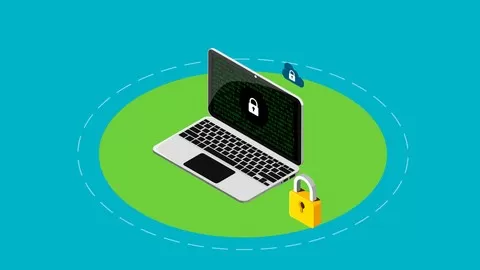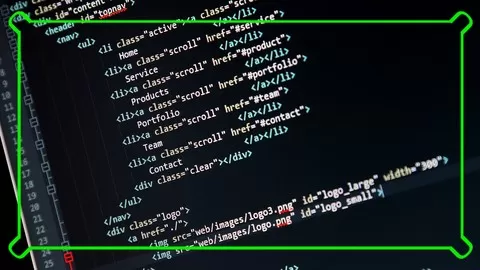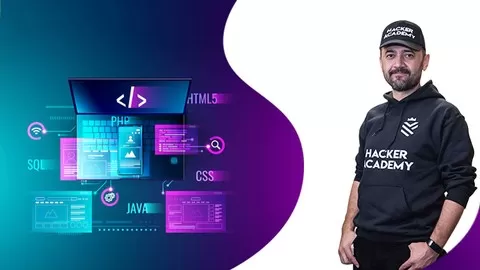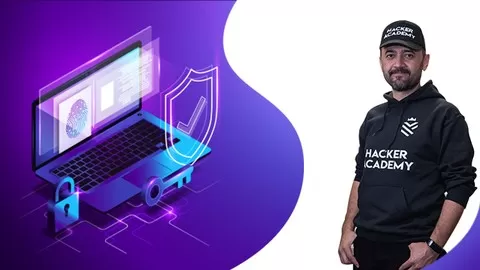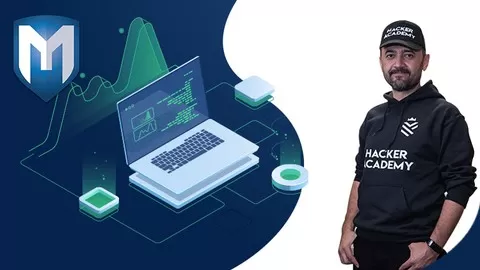Hello,
Welcome to my “Ethical Hacking and Penetration Testing with Free Tools” course.
Learn hackers`Web Hacking, Network Scanning and Password Cracking tools such as Wireshark, Nmap, Metasploit, Maltego
My name is Muharrem Aydin ( white-hat Hacker ), creator of the three best-selling Ethical Hacking and Penetration Testing courses on Udemy.
Whether you want to get your first job in IT security, become a white hat hacker, or prepare to check the security of your own home network, Oak Academy offers practical and accessible ethical hacking courses to help keep your networks safe from cybercriminals.
Penetration testing skills make you a more marketable IT tech. Understanding how to exploit servers, networks, and applications means that you will also be able to better prevent malicious exploitation. From website and network hacking, to pen testing in Python and Metasploit, Oak Academy has a course for you.
Ethical Hacking is in demand. Learn Ethical Hacking penetration testing, web hacking, Metasploit & become an ethical hacker.
Whether you want to get your first job in IT security, become a white hat hacker, or prepare to check the security of your own home network, Oak Academy offers practical and accessible ethical hacking courses to help keep your networks safe from cybercriminals.
This time I’ve designed my “Ethical Hacking and Penetration Testing with Free Tools” course, for YOU! This course is for everyone! If you don’t have any previous experience, not a problem! This course is expertly designed to teach everyone from complete beginners, right through to pro hackers. You’ll go from beginner to extremely high-level and I will take you through each step with hands-on examples.
In this course, I have listed the web’s favorite ethical hacking / pentesting hacker tools as used by hackers, geeks, ethical hackers and security engineers (as well as black hat hackers).
★★★★★ All tools are free. So you don’t need to buy any tool or application. ★★★★★
You will learn the theory, background and trendy free tools used to leverage the most updated attacks in the hacking world with real-world examples and demos.
In this course, you will first learn how to set up a lab ( Kali Linux ) and install needed software on your machine. Then you will learn;
Network Scan Tools
Wireshark, Hping, Nmap, Zenmap
Vulnerability Scan Tool
•Nessus
Exploitation Tool
•Metasploit Framework
Password Cracking Tools
•Hydra, Cain and Abel, John The Ribber
Information Gathering Over the Internet Tools
•SearchDiggity, Shodan, Maltego,
Web Hacking Tools
•Burp Suite, ZAP, Beef, SQLMap
Social Engineering and Phishing Tools
•Veil, Fatrat, Empire Project
&
Network Layer & Layer-2 Attacks Tools
•Yersinia for DHCP Starvation
Here is the list of what you’ll learn by the end of course,
Setting Up The Laboratory
Set Up Kali Linux from VM Image
Set Up Kali Linux from ISO File
Set Up a Victim: Metasploitable Linux
Set Up a Victim: OWASP Broken Web Applications
Set Up a Victim: Windows System
Network Scan Tools
Wireshark: Sniffing the Network Traffic
Wireshark: Following a Stream
Wireshark: Summarise the Network
TCPDump in Action
Hping for Active Scan and DDoS Attacks
Network Scan Tools – NMAP
Ping Scan to Enumerate Network Hosts
Introduction to Port Scan
SYN Scan
Port Scan Details
TCP Scan
UDP Scan
Version Detection
Operating System Detection
Input & Output Management in Nmap
Introduction to Nmap Scripting Engine (NSE)
Nmap Scripting Engine: First Example
Nmap Scripting Engine: Second Example
Some Other Types of Scans: XMAS, ACK, etc.
Idle (Stealth) Scan
Vulnerability Scan Tool: Nessus
Nessus: Introduction
Download & Install Nessus
Creating a Custom Policy
Scanning
Reporting
Exploitation Tool: Metasploit Framework (MSF)
MSF Console: Search Function & Ranking of the Exploits
MSF Console: Configure & Run an Exploit
Meeting with Meterpreter
Meterpreter Basics on Linux
Meterpreter Basics on Windows
Meterpreter for Post-Exploitation
Incognito Extension of Meterpreter
Mimikatz in Meterpreter
Post Modules of Metasploit Framework (MSF)
Managing Post Modules of MSF
Password Cracking Tools
Hydra: Cracking the Password of a Web App
Hydra: Online SSH Password Cracking
Cain and Abel: Install & Run
Cain and Abel: Gathering Hashes
Cain & Abel: A Dictionary Attack
Cain & Abel: A Brute Force Attack
John the Ripper
Information Gathering Over the Internet Tools
SearchDiggity: A Search Engine Tool
Information Gathering Over the Internet Tools
SearchDiggity: A Search Engine Tool
Shodan
FOCA: Fingerprinting Organisations with Collected Archives
The Harvester & Recon-NG
Maltego – Visual Link Analysis Tool
Web App Hacking Tools
Burp Suite: Intercepting the HTTP Traffic
Burp Suite: Intercepting the HTTPS Traffic
Zed Attack Proxy (ZAP): A Web App Vulnerability Scanner
ZAP: Installation & Quick Scan
ZAP: As a Personal Proxy
ZAP: Intercepting the HTTPS Traffic
ZAP: An Advanced Scan – Scanning a Website that Requires to Login
SQLMap: Leveraging an SQL Injection Exploit
Social Engineering and Phishing Tools
Veil: Introduction
Veil: In Action
FatRat: Introduction
FatRat: In Action
Empire Project: Installation
Empire in Action
Social Engineering Toolkit (SET) for Phishing
Network Layer & Layer-2 Attacks Tools
GNS3: Let’s Create Our Network – Download & Install
GNS3: Setting Up the First Project
GNS3: Tool Components
GNS3: Building the Network
GNS3: Attaching VMware VMs (Including Kali) to the Network
GNS3: Configuring Switch & Router (Cisco) and creating VLANs
Macof for MAC Flood
Ettercap for ARP Cache Poisoning
What is Ethical Hacking and what is it used for ?
Ethical hacking involves a hacker agreeing with an organization or individual who authorizes the hacker to levy cyber attacks on a system or network to expose potential vulnerabilities. An ethical hacker is also sometimes referred to as a white hat hacker. Many depend on ethical hackers to identify weaknesses in their networks, endpoints, devices, or applications. The hacker informs their client as to when they will be attacking the system, as well as the scope of the attack. An ethical hacker operates within the confines of their agreement with their client. They cannot work to discover vulnerabilities and then demand payment to fix them. This is what gray hat hackers do. Ethical hackers are also different from black hat hackers, who hack to harm others or benefit themselves without permission.
Is Ethical Hacking a good career?
Yes, ethical hacking is a good career because it is one of the best ways to test a network. An ethical hacker tries to locate vulnerabilities in the network by testing different hacking techniques on them. In many situations, a network seems impenetrable only because it hasn’t succumbed to an attack in years. However, this could be because black hat hackers are using the wrong kinds of methods. An ethical hacker can show a company how they may be vulnerable by levying a new type of attack that no one has ever tried before. When they successfully penetrate the system, the organization can then set up defenses to protect against this kind of penetration. This unique security opportunity makes the skills of an ethical hacker desirable for organizations that want to ensure their systems are well-defended against cybercriminals.
What skills do Ethical Hackers need to know?
In addition to proficiency in basic computer skills and use of the command line, ethical hackers must also develop technical skills related to programming, database management systems (DBMS), use of the Linux operating system (OS), cryptography, creation and management of web applications and computer networks like DHCP, NAT, and Subnetting. Becoming an ethical hacker involves learning at least one programming language and having a working knowledge of other common languages like Python, SQL, C++, and C. Ethical hackers must have strong problem-solving skills and the ability to think critically to come up with and test new solutions for securing systems. Ethical hackers should also understand how to use reverse engineering to uncover specifications and check a system for vulnerabilities by analyzing its code.
Why do hackers use Linux?
Many hackers use the Linux operating system (OS) because Linux is a free and open-source OS, meaning that anyone can modify it. It’s easy to access and customize all parts of Linux, which allows a hacker more control over manipulating the OS. Linux also features a well-integrated command-line interface, giving users a more precise level of control than many other systems offer. While Linux is considered more secure than many other systems, some hackers can modify existing Linux security distributions to use them as hacking software. Most ethical hackers prefer Linux because it’s considered more secure than other operating systems and does not generally require the use of third-party antivirus software. Ethical hackers must be well-versed in Linux to identify loopholes and combat malicious hackers, as it’s one of the most popular systems for web servers.
Is Ethical Hacking Legal?
Yes, ethical hacking is legal because the hacker has full, expressed permission to test the vulnerabilities of a system. An ethical hacker operates within constraints stipulated by the person or organization for which they work, and this agreement makes for a legal arrangement. An ethical hacker is like someone who handles quality control for a car manufacturer. They may have to try to break certain components of the vehicle such as the windshield, suspension system, transmission, or engine to see where they are weak or how they can improve them. With ethical hacking, the hacker is trying to “break” the system to ascertain how it can be less vulnerable to cyberattacks. However, if an ethical hacker attacks an area of a network or computer without getting expressed permission from the owner, they could be considered a gray hat hacker, violating ethical hacking principles.
What is the Certified Ethical Hacker ( CEH ) Certification Exam?
The Certified Ethical Hacker (CEH) certification exam supports and tests the knowledge of auditors, security officers, site administrators, security professionals, and anyone else who wants to ensure a network is safe against cybercriminals. With the CEH credential, you can design and govern the minimum standards necessary for credentialing information that security professionals need to engage in ethical hacking. You can also make it known to the public if someone who has earned their CEH credentials has met or exceeded the minimum standards. You are also empowered to reinforce the usefulness and self-regulated nature of ethical hacking. The CEH exam doesn’t cater to specific security hardware or software vendors, such as Fortinet, Avira, Kaspersky, Cisco, or others, making it a vendor-neutral program.
What is the Certified Information Security Manager ( CISM ) exam?
Passing the Certified Information Security Manager (CISM) exam indicates that the credentialed individual is an expert in the governance of information security, developing security programs and managing them, as well as managing incidents and risk. For someone to be considered “certified,” they must have passed the exam within the last five years, as well as work full-time in a related career, such as information security and IT administration. The exam tests individuals’ knowledge regarding the risks facing different systems, how to develop programs to assess and mitigate these risks, and how to ensure an organization’s information systems conform to internal and regulatory policies. The exam also assesses how a person can use tools to help an organization recover from a successful attack.
What are the different types of hackers?
The different types of hackers include white hat hackers who are ethical hackers and are authorized to hack systems, black hat hackers who are cybercriminals, and grey hat hackers, who fall in-between and may not damage your system but hack for personal gain. There are also red hat hackers who attack black hat hackers directly. Some call new hackers green hat hackers. These people aspire to be full-blown, respected hackers. State-sponsored hackers work for countries and hacktivists and use hacking to support or promote a philosophy. Sometimes a hacker can act as a whistleblower, hacking their own organization in order to expose hidden practices. There are also script kiddies and blue hat hackers. A script kiddie tries to impress their friends by launching scripts and download tools to take down websites and networks. When a script kiddie gets angry at…
FAQ regarding Penetration Testing :
What is penetration testing?
Penetration testing, or pen testing, is the process of attacking an enterprise’s network to find any vulnerabilities that could be present to be patched. Ethical hackers and security experts carry out these tests to find any weak spots in a system’s security before hackers with malicious intent find them and exploit them. Someone who has no previous knowledge of the system’s security usually performs these tests, making it easier to find vulnerabilities that the development team may have overlooked. You can perform penetration testing using manual or automated technologies to compromise servers, web applications, wireless networks, network devices, mobile devices, and other exposure points.
What are the different types of penetration testing?
There are many types of penetration testing. Internal penetration testing tests an enterprise’s internal network. This test can determine how much damage can be caused by an employee. An external penetration test targets a company’s externally facing technology like their website or their network. Companies use these tests to determine how an anonymous hacker can attack a system. In a covert penetration test, also known as a double-blind penetration test, few people in the company will know that a pen test is occurring, including any security professional. This type of test will test not only systems but a company’s response to an active attack. With a closed-box penetration test, a hacker may know nothing about the enterprise under attack other than its name. In an open-box test, the hacker will receive some information about a company’s security to aid them in the attack.
What are the different stages of penetration testing?
Penetration tests have five different stages. The first stage defines the goals and scope of the test and the testing methods that will be used. Security experts will also gather intelligence on the company’s system to better understand the target. The second stage of a pen test is scanning the target application or network to determine how they will respond to an attack. You can do this through a static analysis of application code and dynamic scans of running applications and networks. The third stage is the attack phase, when possible vulnerabilities discovered in the last stage are attacked with various hacking methods. In the fourth stage of a penetration test, the tester attempts to maintain access to the system to steal any sensitive data or damaging systems. The fifth and final stage of a pen test is the reporting phase, when testers compile the test results.
You’ll also get:
•Lifetime Access to The Course
•Fast & Friendly Support in the Q&A section
•Udemy Certificate of Completion Ready for Download
Enroll now to become professional Free Tools for Penetration Testing and Ethical Hacking!
IMPORTANT: This course is created for educational purposes and all the information learned should be used when the attacker is authorized.




